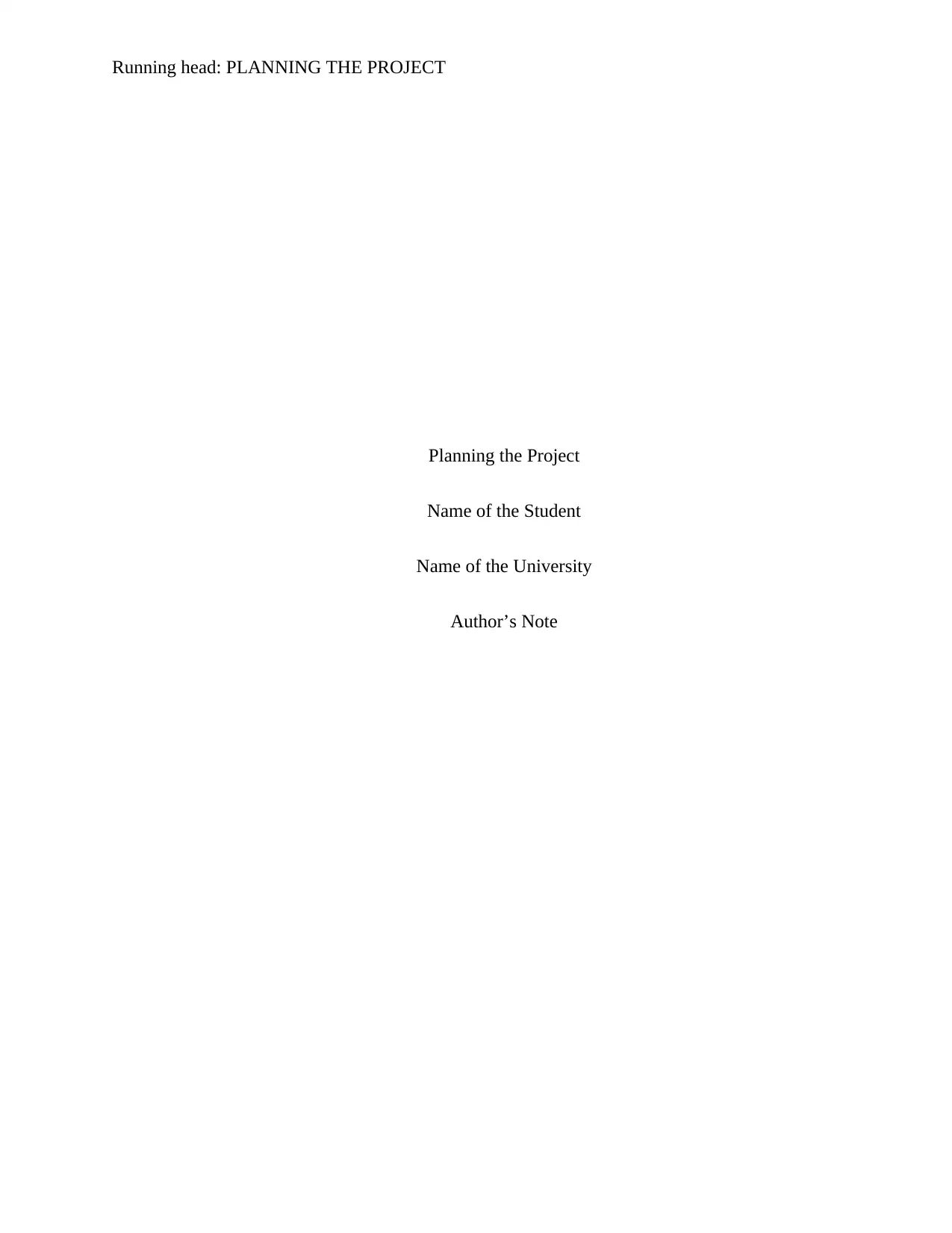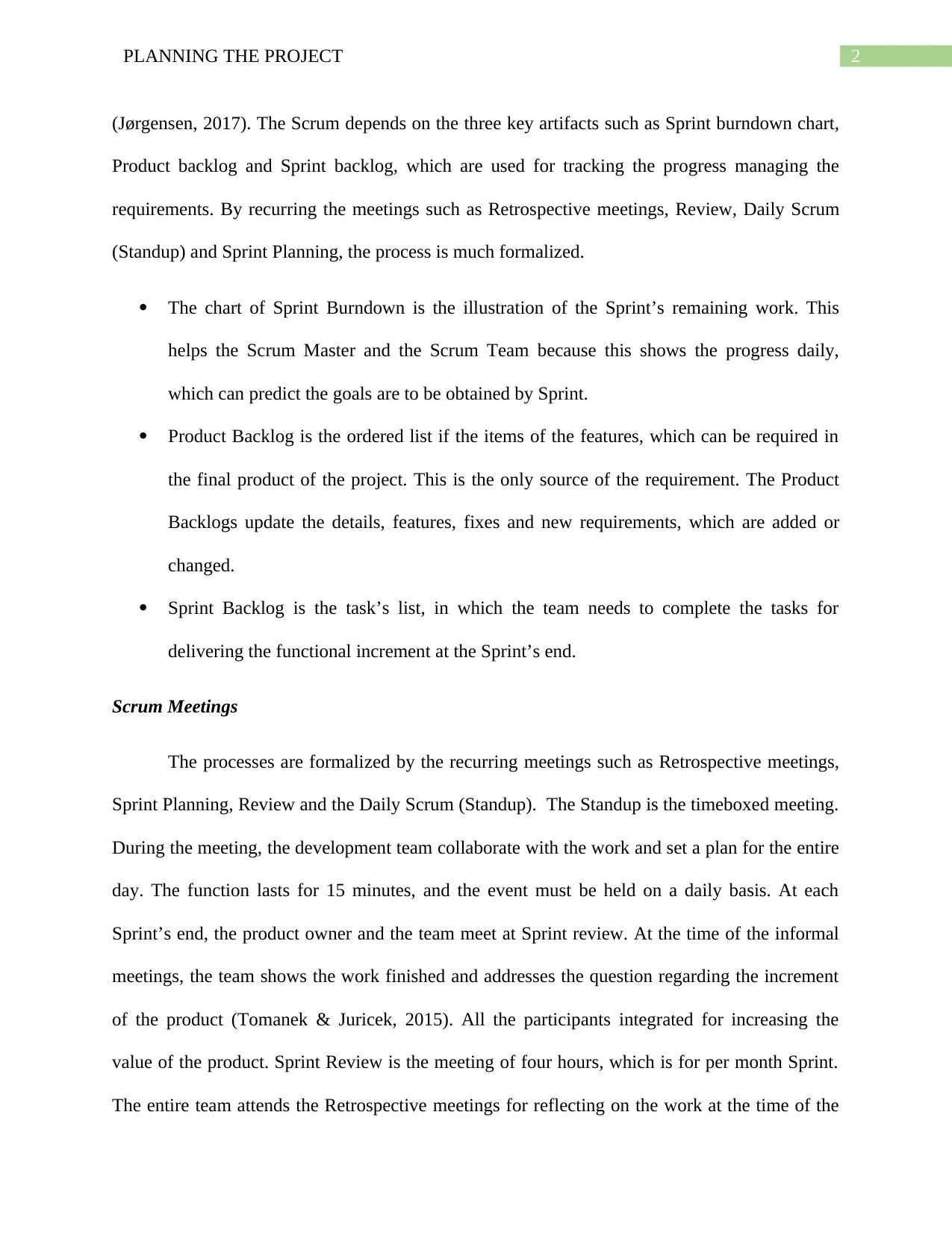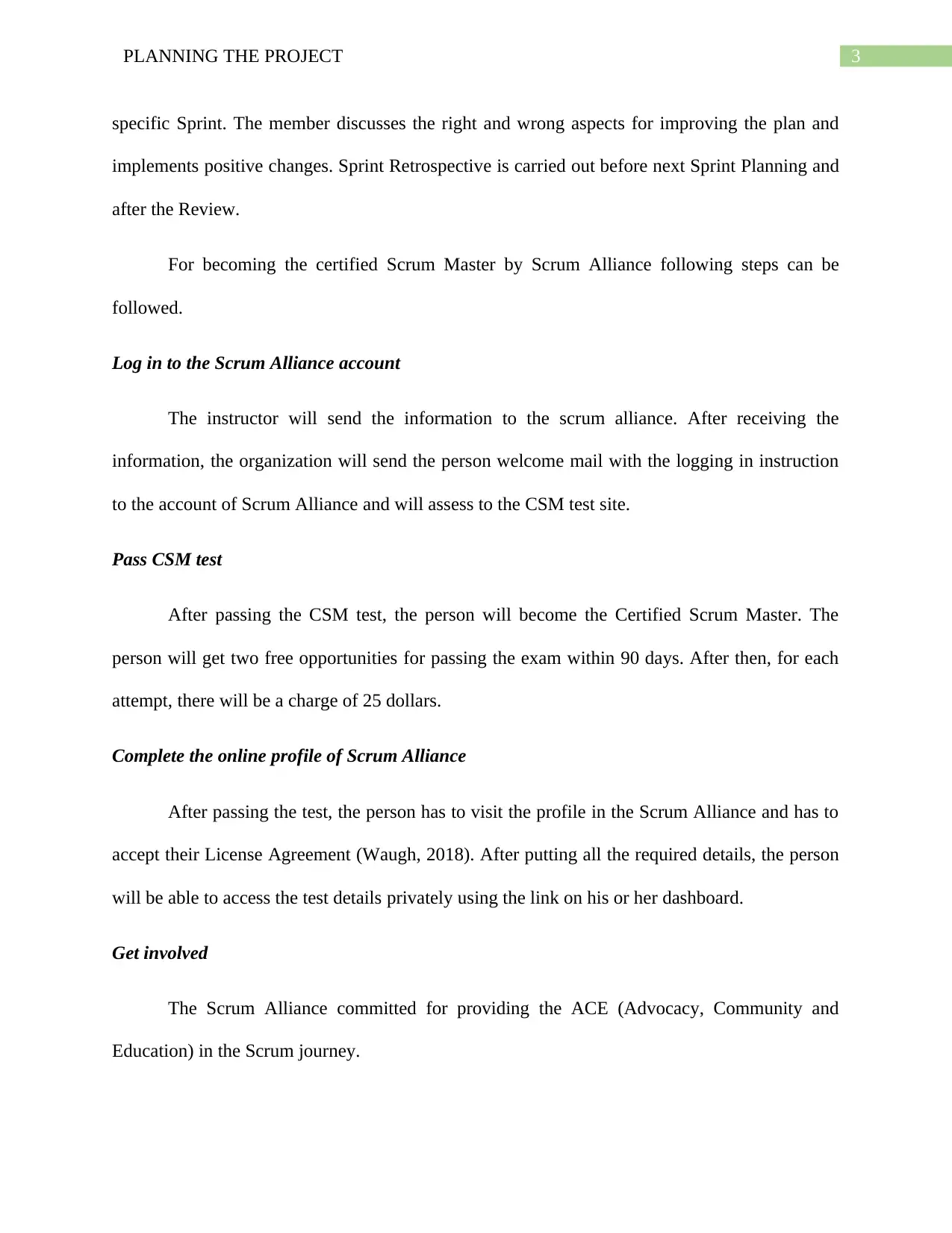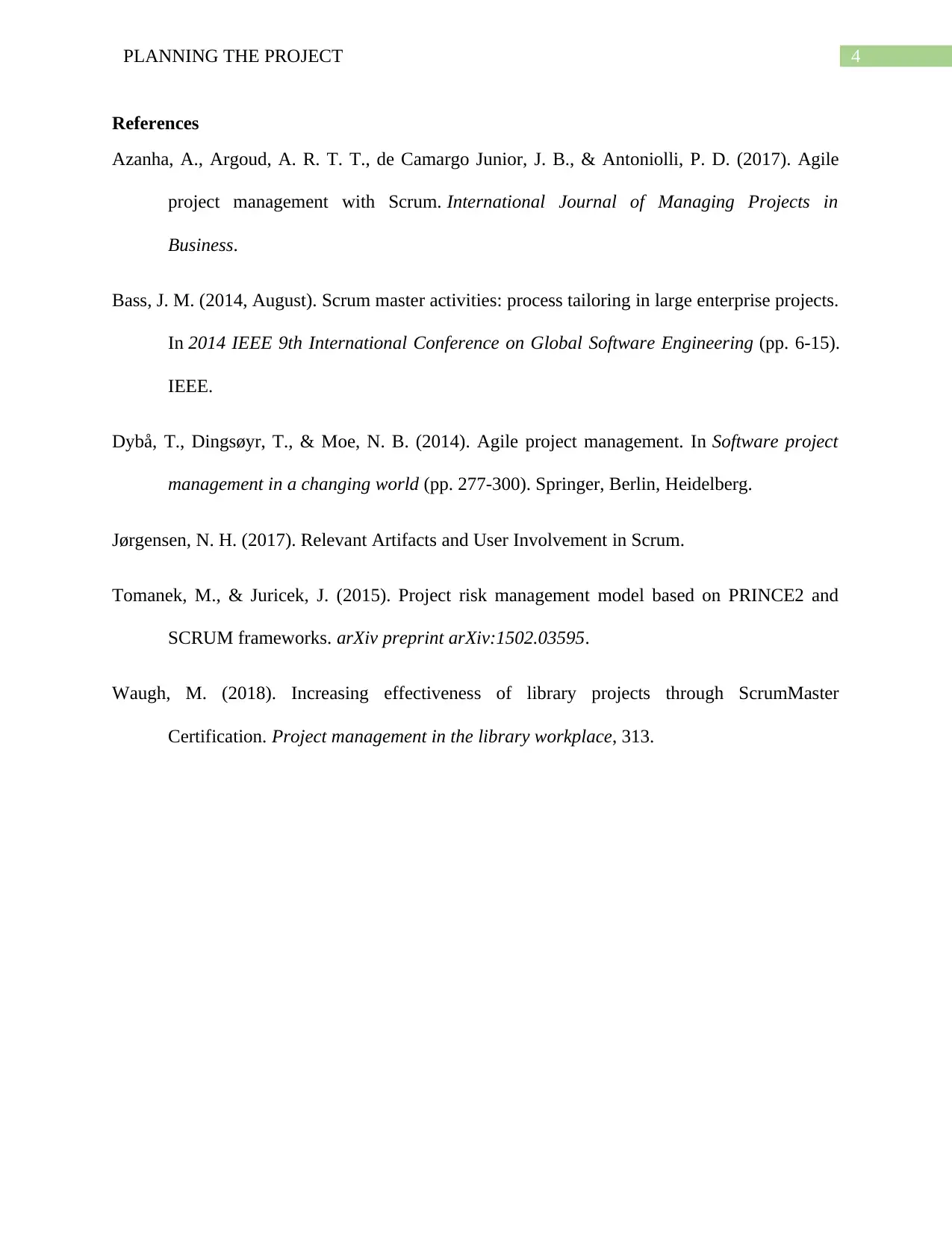Detailed Analysis of Planning the Project Using Agile and Scrum
VerifiedAdded on 2022/08/17
|5
|1092
|13
Report
AI Summary
This report delves into the principles of Agile project management, focusing on the Scrum methodology. It highlights the importance of adaptiveness, continuous improvement, and collaboration in delivering complex projects. The report outlines the key roles within Scrum, including the Product Owner, Scrum Master, and the Scrum Team, and explains their responsibilities. It details the significance of Sprints, artifacts like Sprint Burndown charts, Product Backlogs, and Sprint Backlogs, and recurring meetings such as Sprint Planning, Daily Scrum, Sprint Review, and Retrospective meetings. Furthermore, the report provides a step-by-step guide on obtaining Scrum Master certification and includes references to relevant research and publications. The report emphasizes the structured collaboration and iterative approach central to the Scrum framework, aiming to provide a comprehensive understanding of Agile project planning.

Running head: PLANNING THE PROJECT
Planning the Project
Name of the Student
Name of the University
Author’s Note
Planning the Project
Name of the Student
Name of the University
Author’s Note
Paraphrase This Document
Need a fresh take? Get an instant paraphrase of this document with our AI Paraphraser

1PLANNING THE PROJECT
Agile project management is the methodology, which is used for delivering complex
projects because of the adaptiveness (Dybå, Dingsøyr & Moe, 2014). This emphasizes the
continuous improvement, flexibility, high-quality outcomes and collaboration. This methodology
aims for being measurable and clear by using the deliverables for creating the product and
tracking the progress.
Scrum aims at the sustainability of strong collaboration among the people, who are
working on complex projects, and the details are added or changes (Azanha et al., 2017). This is
based on the structured collaboration among the three key positions such as Product Owner,
Scrum Master and the Project Team.
Product Owner, any stakeholder or client is involved in the project by conveying the
vision of those products and provide regular feedback about the current project after each
Sprint.
Scrum Master is the main figure in the project. The key responsibility of the scrum
master is to eliminate the obstacles, which may prevent the efficient work of the team
(Bass, 2014).
Scrum Team is a self-organizing and cross-functional team, which is responsible for the
implementation of the product. This needs to consist of 7-8 members for staying
productive and flexible.
Sprints and Artifacts
Sprint is the fundamental action in the Scrum, which has a short cycle in of development,
and it is required for producing the shippable products. Sprint can be within 1 week to 4 weeks.
The lengthy work can lack flexibility and predictability, which are the basic benefit of Scrum
Agile project management is the methodology, which is used for delivering complex
projects because of the adaptiveness (Dybå, Dingsøyr & Moe, 2014). This emphasizes the
continuous improvement, flexibility, high-quality outcomes and collaboration. This methodology
aims for being measurable and clear by using the deliverables for creating the product and
tracking the progress.
Scrum aims at the sustainability of strong collaboration among the people, who are
working on complex projects, and the details are added or changes (Azanha et al., 2017). This is
based on the structured collaboration among the three key positions such as Product Owner,
Scrum Master and the Project Team.
Product Owner, any stakeholder or client is involved in the project by conveying the
vision of those products and provide regular feedback about the current project after each
Sprint.
Scrum Master is the main figure in the project. The key responsibility of the scrum
master is to eliminate the obstacles, which may prevent the efficient work of the team
(Bass, 2014).
Scrum Team is a self-organizing and cross-functional team, which is responsible for the
implementation of the product. This needs to consist of 7-8 members for staying
productive and flexible.
Sprints and Artifacts
Sprint is the fundamental action in the Scrum, which has a short cycle in of development,
and it is required for producing the shippable products. Sprint can be within 1 week to 4 weeks.
The lengthy work can lack flexibility and predictability, which are the basic benefit of Scrum

2PLANNING THE PROJECT
(Jørgensen, 2017). The Scrum depends on the three key artifacts such as Sprint burndown chart,
Product backlog and Sprint backlog, which are used for tracking the progress managing the
requirements. By recurring the meetings such as Retrospective meetings, Review, Daily Scrum
(Standup) and Sprint Planning, the process is much formalized.
The chart of Sprint Burndown is the illustration of the Sprint’s remaining work. This
helps the Scrum Master and the Scrum Team because this shows the progress daily,
which can predict the goals are to be obtained by Sprint.
Product Backlog is the ordered list if the items of the features, which can be required in
the final product of the project. This is the only source of the requirement. The Product
Backlogs update the details, features, fixes and new requirements, which are added or
changed.
Sprint Backlog is the task’s list, in which the team needs to complete the tasks for
delivering the functional increment at the Sprint’s end.
Scrum Meetings
The processes are formalized by the recurring meetings such as Retrospective meetings,
Sprint Planning, Review and the Daily Scrum (Standup). The Standup is the timeboxed meeting.
During the meeting, the development team collaborate with the work and set a plan for the entire
day. The function lasts for 15 minutes, and the event must be held on a daily basis. At each
Sprint’s end, the product owner and the team meet at Sprint review. At the time of the informal
meetings, the team shows the work finished and addresses the question regarding the increment
of the product (Tomanek & Juricek, 2015). All the participants integrated for increasing the
value of the product. Sprint Review is the meeting of four hours, which is for per month Sprint.
The entire team attends the Retrospective meetings for reflecting on the work at the time of the
(Jørgensen, 2017). The Scrum depends on the three key artifacts such as Sprint burndown chart,
Product backlog and Sprint backlog, which are used for tracking the progress managing the
requirements. By recurring the meetings such as Retrospective meetings, Review, Daily Scrum
(Standup) and Sprint Planning, the process is much formalized.
The chart of Sprint Burndown is the illustration of the Sprint’s remaining work. This
helps the Scrum Master and the Scrum Team because this shows the progress daily,
which can predict the goals are to be obtained by Sprint.
Product Backlog is the ordered list if the items of the features, which can be required in
the final product of the project. This is the only source of the requirement. The Product
Backlogs update the details, features, fixes and new requirements, which are added or
changed.
Sprint Backlog is the task’s list, in which the team needs to complete the tasks for
delivering the functional increment at the Sprint’s end.
Scrum Meetings
The processes are formalized by the recurring meetings such as Retrospective meetings,
Sprint Planning, Review and the Daily Scrum (Standup). The Standup is the timeboxed meeting.
During the meeting, the development team collaborate with the work and set a plan for the entire
day. The function lasts for 15 minutes, and the event must be held on a daily basis. At each
Sprint’s end, the product owner and the team meet at Sprint review. At the time of the informal
meetings, the team shows the work finished and addresses the question regarding the increment
of the product (Tomanek & Juricek, 2015). All the participants integrated for increasing the
value of the product. Sprint Review is the meeting of four hours, which is for per month Sprint.
The entire team attends the Retrospective meetings for reflecting on the work at the time of the
⊘ This is a preview!⊘
Do you want full access?
Subscribe today to unlock all pages.

Trusted by 1+ million students worldwide

3PLANNING THE PROJECT
specific Sprint. The member discusses the right and wrong aspects for improving the plan and
implements positive changes. Sprint Retrospective is carried out before next Sprint Planning and
after the Review.
For becoming the certified Scrum Master by Scrum Alliance following steps can be
followed.
Log in to the Scrum Alliance account
The instructor will send the information to the scrum alliance. After receiving the
information, the organization will send the person welcome mail with the logging in instruction
to the account of Scrum Alliance and will assess to the CSM test site.
Pass CSM test
After passing the CSM test, the person will become the Certified Scrum Master. The
person will get two free opportunities for passing the exam within 90 days. After then, for each
attempt, there will be a charge of 25 dollars.
Complete the online profile of Scrum Alliance
After passing the test, the person has to visit the profile in the Scrum Alliance and has to
accept their License Agreement (Waugh, 2018). After putting all the required details, the person
will be able to access the test details privately using the link on his or her dashboard.
Get involved
The Scrum Alliance committed for providing the ACE (Advocacy, Community and
Education) in the Scrum journey.
specific Sprint. The member discusses the right and wrong aspects for improving the plan and
implements positive changes. Sprint Retrospective is carried out before next Sprint Planning and
after the Review.
For becoming the certified Scrum Master by Scrum Alliance following steps can be
followed.
Log in to the Scrum Alliance account
The instructor will send the information to the scrum alliance. After receiving the
information, the organization will send the person welcome mail with the logging in instruction
to the account of Scrum Alliance and will assess to the CSM test site.
Pass CSM test
After passing the CSM test, the person will become the Certified Scrum Master. The
person will get two free opportunities for passing the exam within 90 days. After then, for each
attempt, there will be a charge of 25 dollars.
Complete the online profile of Scrum Alliance
After passing the test, the person has to visit the profile in the Scrum Alliance and has to
accept their License Agreement (Waugh, 2018). After putting all the required details, the person
will be able to access the test details privately using the link on his or her dashboard.
Get involved
The Scrum Alliance committed for providing the ACE (Advocacy, Community and
Education) in the Scrum journey.
Paraphrase This Document
Need a fresh take? Get an instant paraphrase of this document with our AI Paraphraser

4PLANNING THE PROJECT
References
Azanha, A., Argoud, A. R. T. T., de Camargo Junior, J. B., & Antoniolli, P. D. (2017). Agile
project management with Scrum. International Journal of Managing Projects in
Business.
Bass, J. M. (2014, August). Scrum master activities: process tailoring in large enterprise projects.
In 2014 IEEE 9th International Conference on Global Software Engineering (pp. 6-15).
IEEE.
Dybå, T., Dingsøyr, T., & Moe, N. B. (2014). Agile project management. In Software project
management in a changing world (pp. 277-300). Springer, Berlin, Heidelberg.
Jørgensen, N. H. (2017). Relevant Artifacts and User Involvement in Scrum.
Tomanek, M., & Juricek, J. (2015). Project risk management model based on PRINCE2 and
SCRUM frameworks. arXiv preprint arXiv:1502.03595.
Waugh, M. (2018). Increasing effectiveness of library projects through ScrumMaster
Certification. Project management in the library workplace, 313.
References
Azanha, A., Argoud, A. R. T. T., de Camargo Junior, J. B., & Antoniolli, P. D. (2017). Agile
project management with Scrum. International Journal of Managing Projects in
Business.
Bass, J. M. (2014, August). Scrum master activities: process tailoring in large enterprise projects.
In 2014 IEEE 9th International Conference on Global Software Engineering (pp. 6-15).
IEEE.
Dybå, T., Dingsøyr, T., & Moe, N. B. (2014). Agile project management. In Software project
management in a changing world (pp. 277-300). Springer, Berlin, Heidelberg.
Jørgensen, N. H. (2017). Relevant Artifacts and User Involvement in Scrum.
Tomanek, M., & Juricek, J. (2015). Project risk management model based on PRINCE2 and
SCRUM frameworks. arXiv preprint arXiv:1502.03595.
Waugh, M. (2018). Increasing effectiveness of library projects through ScrumMaster
Certification. Project management in the library workplace, 313.
1 out of 5
Related Documents
Your All-in-One AI-Powered Toolkit for Academic Success.
+13062052269
info@desklib.com
Available 24*7 on WhatsApp / Email
![[object Object]](/_next/static/media/star-bottom.7253800d.svg)
Unlock your academic potential
Copyright © 2020–2025 A2Z Services. All Rights Reserved. Developed and managed by ZUCOL.





